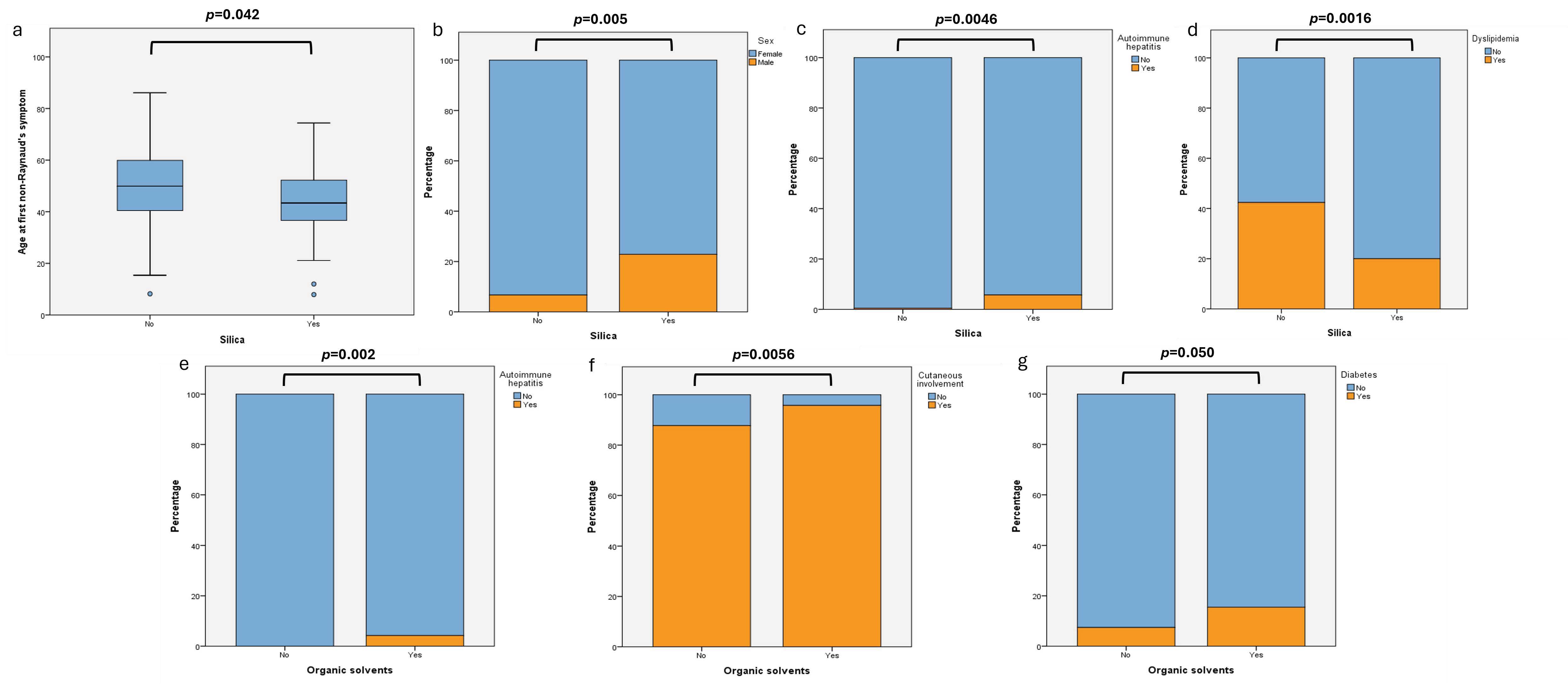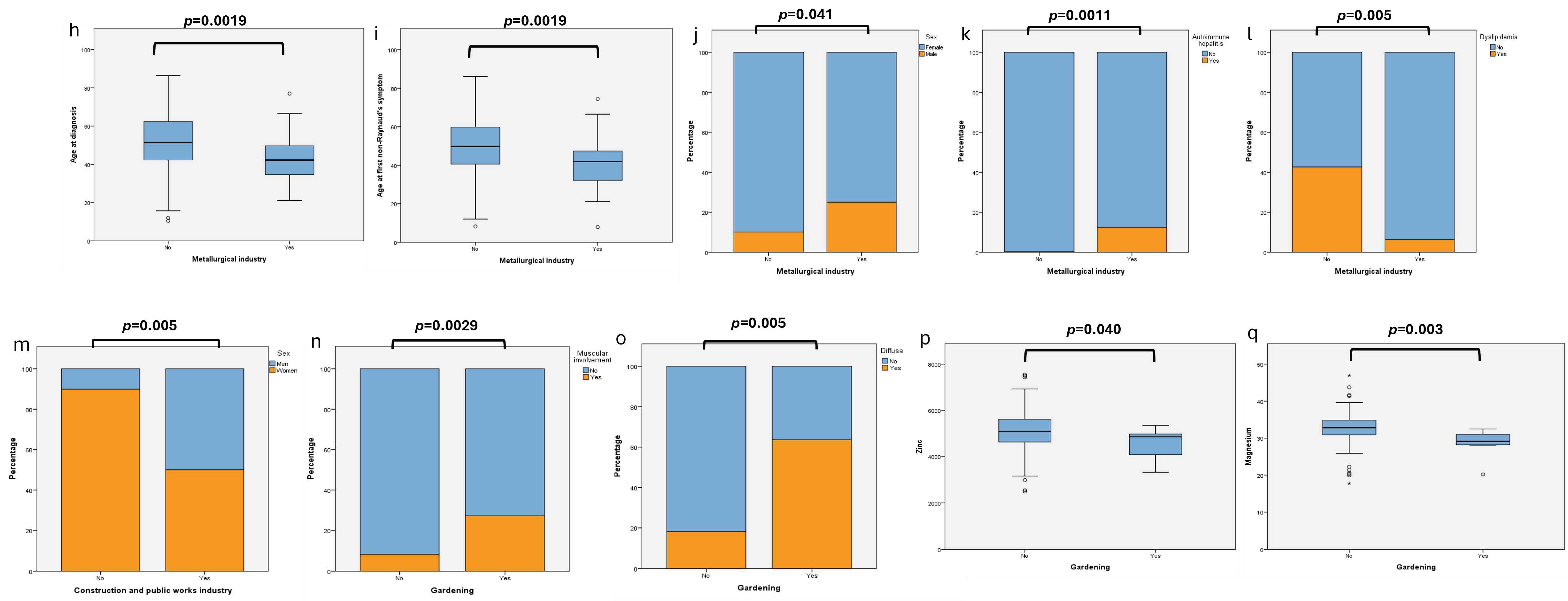Session Information
Session Type: Poster Session A
Session Time: 10:30AM-12:30PM
Background/Purpose: Environmental factors have been proposed as a trigger for systemic sclerosis (SSc) in genetically predisposed individuals. This study aimed to investigate the association between occupational exposure to pollutants and specific clinical and serological phenotypes in SSc.
Methods: Ambispective study performed in 3 tertiary Spanish hospitals. Patients diagnosed with any subtype of SSc who signed the informed consent were included. Detailed demographic, clinical, and serological data, and PROs were collected, along with information on occupational exposure to pollutants gathered through an extensive questionnaire answered by each patient. Blood samples were collected and 61 elements (including macroelements, microelements and toxic elements), were quantified. Information on the relationship between work activities and exposition to the studied pollutants was obtained from the Canadian Job Exposure Matrix database. The statistical analysis to study associations was performed using non-parametric tests (the χ2 and Fisher’s exact test for categorical variables and the Kruskal-Wallis test for continuous), followed by a post hoc analysis to evaluate the differences between groups. The odds ratios (OR) and their 95% confidence intervals (CI) were computed using the unconditional maximum likelihood estimation.
Results: Occupational information was available for 259/313 individuals. Patients with occupational exposure to silica were younger at inclusion in the study (p=0.023) and onset of the 1st non-Raynaud symptom (p=0.042). Male patients had a a 4.3-fold higher risk of having been exposed to silica than females (95% CI 1.58-11.11, p=0.005). Silica exposure was also associated to more frequent autoimmune hepatitis (AIH) (OR 12.9; 95% CI 1.02-413.5, p=0.046) and less dyslipidemia (OR 0.4; 95% CI 0.1-0.8, p=0.016). Exposure to organic solvents increased the presence of diabetes (OR 2.3; 95% CI 1-5.3, p = 0.050), AIH (OR 8.17; 95% CI 1-377.8, p=0.02) and almost the odds of cutaneous involvement (OR 3; 95% CI 1-13.6, p=0.056) (Fig. 1). Exposure to the metallurgical industry was associated with younger age at inclusion in the study (p=0.013), male sex (OR 3.60; 95% CI 1.06-12.25, p=0.041), age at diagnosis (p=0.019), age at 1rst non-Raynaud symptom (p=0.019), more AIH (OR 31.2; 95% CI 2.4-1015.8, p=0.011) and less dyslipidemia (OR 0.1; 95% CI 0.004-0.5, p=0.005). The construction industry was associated with male sex (OR 10.65; 95% CI 1.01-56.27, p=0.005). Gardening was linked to the diffuse SSc subtype (OR 7.68; 95% CI 2.16-27.35, p=0.002), muscular involvement (OR 4.79; 95% CI 1.17-19.65, p=0.029), and lower serum concentrations of zinc (p=0.040) and magnesium (p=0.003) (Fig. 2).
Conclusion: Occupational exposure to pollutants, particularly silica, organic solvents, and compounds used in the metallurgical industry and gardening is associated with specific clinical and serological phenotypes in SSc patients. These findings highlight the role of environmental factors in shaping the disease phenotype and emphasize the importance of considering occupational history in the management and prognosis of SSc patients.
To cite this abstract in AMA style:
Sanahuja i Sanz M, Carrión-Barberà I, Tío L, Triginer L, Lee M, Guillén-del Castillo A, Ribes A, Valencia Muntalà L, Monfort J, Salman Monte: T, Narvaez-García J, Simeón-Aznar C, Pros A. Influence of Occupational Exposure to Pollutants on Clinical and Serological Phenotypes in Systemic Sclerosis [abstract]. Arthritis Rheumatol. 2024; 76 (suppl 9). https://acrabstracts.org/abstract/influence-of-occupational-exposure-to-pollutants-on-clinical-and-serological-phenotypes-in-systemic-sclerosis/. Accessed .« Back to ACR Convergence 2024
ACR Meeting Abstracts - https://acrabstracts.org/abstract/influence-of-occupational-exposure-to-pollutants-on-clinical-and-serological-phenotypes-in-systemic-sclerosis/


